More Toys and Books
This web page contains reference information and photos regarding the following toy and book topics:
1.) Vintage 12-Inch Action Figures (other than Marx and GI Joe)
2.) GI Joe Mysteries - "21 Movable Parts" and "15 Different Uniforms"
3.) The 1967 Pan-American Games (Winnipeg) "Pepsi-Cola Premium" Plastic Sports Figures
4.) (Temporarily Under Construction)
5.) Canadian Cereal Toy Premiums
6.) Vintage 1970's Archie Comics Digests
7.) Vintage 1960's Series Books
--------------------------------------------------------------------------
1.) Vintage 12-Inch Action Figures (other than Marx and GI Joe)
Although Louis Marx & Co., Inc., with their prolific line-up of "The Best of the West" action figures, and Hasbro (Hassenfeld Bros., Inc.), with their innovative and ever expansive G.I. Joe line-up, jointly dominated the 12-inch action figure market from 1964-1976, there were other players in the market, too. Albeit for much briefer periods of time, they still managed to add some extra "spice" to the decision-making process that youngsters had to undergo to determine where their allowance moneys would be spent.
Pictured below are a number of the more memorable characters from these "alternate" action figure series.
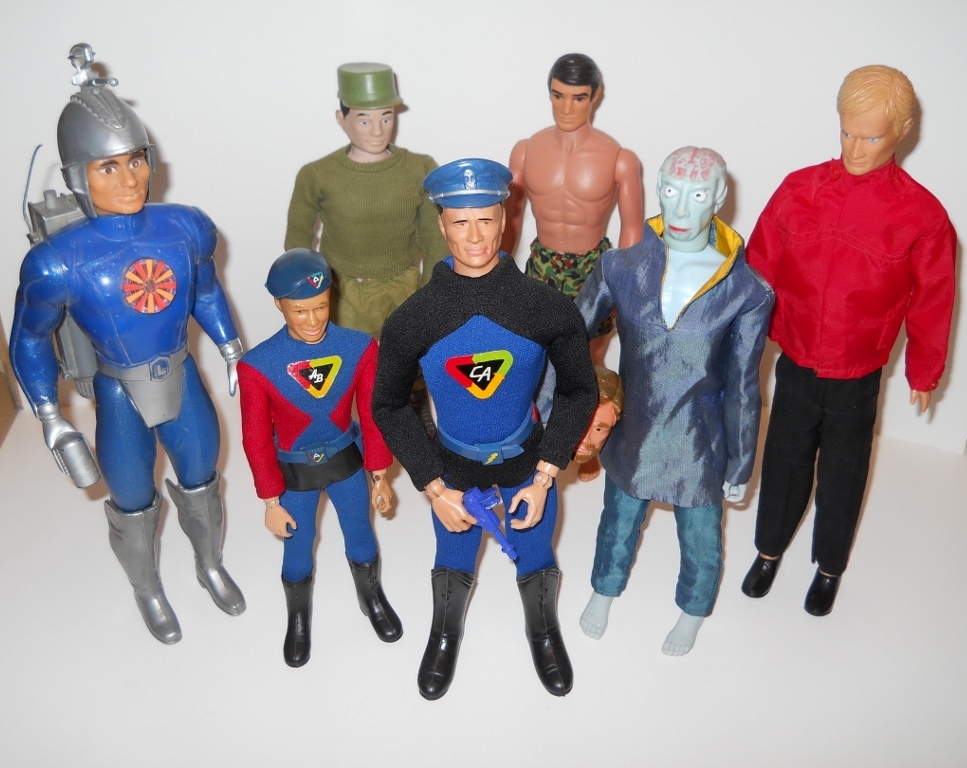
Pictured in the center of the photo is the action figure that likely represented the biggest threat to Marx and Hasbro's oligopoly. He was, of course, Ideal's "Captain Action."
After making his debut in 1966, the Captain was soon to be aided by his trusty sidekick, Action Boy (who appears to the immediate left in the photo) in 1967. The Ideal line-up was expanded yet again in 1968 with the appearance of the Captain's blue-skinned arch enemy, Dr. Evil (on the right). Unfortunately, this great action figure series did not last much longer than its 3-year spot in the sun, as it disappeared from retail toy shelves all together by 1969.
It is unfortunate, too, since Ideal's "Captain Action" series offered us our sole chance to experience our favorite super-heroes in a 12-inch format (thanks to Captain Action and Action Boy's ability to morph into DC, Marvel, King Features Syndicate and other comic book stars). We would not see 12-Inch super-heroes again until the late 1970's, when Mego's Wonder Woman, Superman, the Incredible Hulk and others would make their debut.
But, no sooner did Captain Action make his exit than he would be replaced by another "Captain." Mattel's "Captain Lazer" burst onto the scene in 1968 as an over-sized member of the Major Matt Mason space adventures line-up. Although his "gigantic" 12-inch height was disproportionate to the other characters in the Matt Mason series, he was the perfect height to interact with GI Joe and other action figures. His "hard plastic" body was molded from a styrene (model kit) plastic, which made him a bit less attractive as an action figure, but still, his fully articulated arms, legs, head and knees, along with his other special attributes (ray gun attachments, etc.), more than made up for this shortcoming. Captain Lazer appears on the far left in the above photo.
(Side note: It is truly unfortunate, too, that no one, back in the day, saw fit to inform Mattel that a ray gun that shot out a light beam was also known as a "LASER," an acronym for Light Amplification by Stimulated Emission of Radiation, and not a "LAZER." The true definition of a "lazer" is one who passes time in idleness or relaxation. Sorry, Cap!)
In 1965, right around the same time that Marx was unveiling its first Johnny West series characters, the A. C. Gilbert Company also decided to enter the 12-inch fray when they ran TV commercials for their new "James Bond" and "Odd Job" action figures. The A. C. Gilbert Company was then better known for its toy trains and Erector sets, but they also wanted to cash in on the 12-inch craze that GI Joe had started.
With the sales success of the Bond and Odd Job figures, Gilbert expanded their line-up in 1966 with two Man from U.N.C.L.E. characters, a "Honey West" doll and a "Moon McDare" action figure. The "U.N.C.L.E." figures were Napoleon Solo and Illya Kuryakin, and it is "Illya" that appears on the far right of the above photo.
Although the six different Gilbert characters did sell well, and, for collectors today, they are sought-after figures, they had limited articulation and fairly cheap hollow plastic molded bodies, which make them rather "poor brothers" to GI Joe and Johnny West.
The back row contains a Princess Grace Toy's (Mego) Johnny Canuck figure (who we have already featured in greater detail under the "Vintage Action Figures" menu tab) and a Hasbro "Defenders" figure. Although the Defenders figure is also a Hasbro product, he is technically not a member of the GI Joe action figure line-up. The Defenders figure first debuted in 1975.
So, for GI Joe collectors and Marx "Best of the West" collectors, these figures may hold little appeal. But, for other vintage 12-inch action figure collectors, these Mego, Mattel, Gilbert and Ideal action figures are welcome additions to any well-rounded collection.
2.) GI Joe Mysteries - "21 Movable Parts" and "15 Different Uniforms"
Mystery #1 - 21 Movable Parts
In the 1964 GI Joe Salesman's Catalog, one of the ads contained therein states that "GI Joe has 21 Movable Parts." But, does he? Pictured below is the 1964 ad, with the photo of a GI Joe action figure located directly beneath it. Can you name the "21 Movable Parts?"

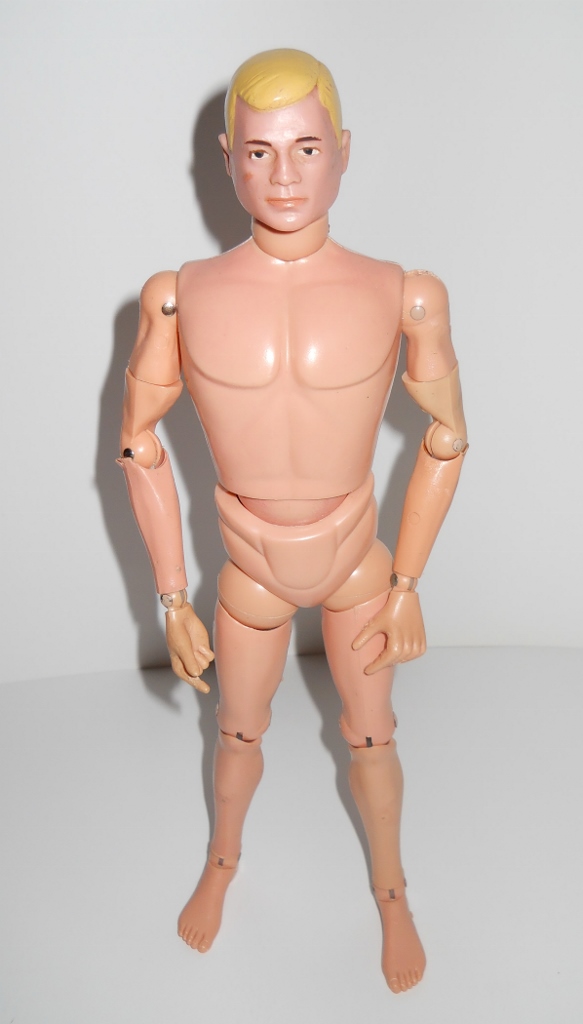
What is confusing about this ad is the fact that the text and the "red dots" pictured in the GI Joe diagram do not correlate.
If you look at the position of the "red dots," they seem to be situated as follows: 1 dot on the Head, 2 on the top Upper Arms, 2 on the lower Upper Arms, 2 on the Forearms, 2 on the Hands, 2 on the Wrists, 1 on the Torso, 1 at the Waist, 2 at the Hips, 2 at the Thighs, 2 on the Lower Legs, and 2 on the Feet - for a total of 21 parts.
Other than for the fact that the 2 wrists are shown as being separate and distinct from each hand, these "red dots" correlate fairly well to the GI Joe figure shown above. His actual distinct body parts being: 2 feet, 2 lower legs, 2 thighs, 2 ball joints for the hips, 1 lower torso/waist, 1 upper torso, 2 hands, 2 forearms, 2 lower-upper arms, 2 upper shoulders, 1 head and 1 head pin - for a total of 20 unique, individual plastic body parts.
If we consider the head and the head pin as only a single part, there are 19 distinct body parts that make up each figure, versus the advertised 21 "movable" parts.
But, if we read the "text" of the ad, we will quickly see that the 21 "red dot" areas are NOT the 21 distinct body parts. The ad states that the 21 movable parts are: 1 head, 2 shoulders, 2 hips, 2 upper arms, 2 forearms, 2 hands, 2 thighs, 2 knees, 2 lower legs, 2 ankles, and 2 feet - for a total of 21 parts.
Yet, the "ankles" are not pictured with red dots on them; the "wrists" are not listed as being separate from the "hands" (but both the wrists and hands are pictured with dots on them, nonetheless); the "knees" are identified as being separate and distinct movable parts from both the "thighs" and the "lower legs," but red dots do not appear at the knee joints; and there is no mention of the "waist" or the "upper torso" anywhere in the text, only the two hips (ball joints) are mentioned, but red dots are clearly evident on the two torso components in the diagram.
If the original intent was not to list the separate body parts, but to list the individual points of articulation, one would assume that the "shoulders" reference implies simply the shoulder "joints," and that the "upper arms" reference includes both the top upper arm and the lower upper arm, with no indication being made of the central upper arm swivel joint. Likewise, the reference to the "knees" obviously means the knee "joints." But, if this is the case, why are the "elbows" not listed? And, why is there no mention of the fact that the "waist" and the upper "torso" move independently of one another?
Perhaps we are destined to never know.
Mystery #2 - 15 Uniforms (Andy and George)
In the September 1966 issues of D.C. comics, a GI Joe "Andy and George" ad appears under the title of "Combat Squad Gets Decorations." The photo below depicts this ad.

In the body of the text, it states that there were "fifteen" different GI Joe uniforms then available. (Note that this ad precedes the release of the six GI Joe Foreign Soldiers of the World, the GI Joe Green Beret and the GI Joe Astronaut and, therefore, those figures' uniforms are not part of the fifteen uniforms being referred to.)
Pictured below is a close-up of the first frame of the cartoon ad and, directly below it, a photo of a number of actual GI Joes dressed in the same uniforms (but note that our "scuba diver" is lacking his black wet suit).

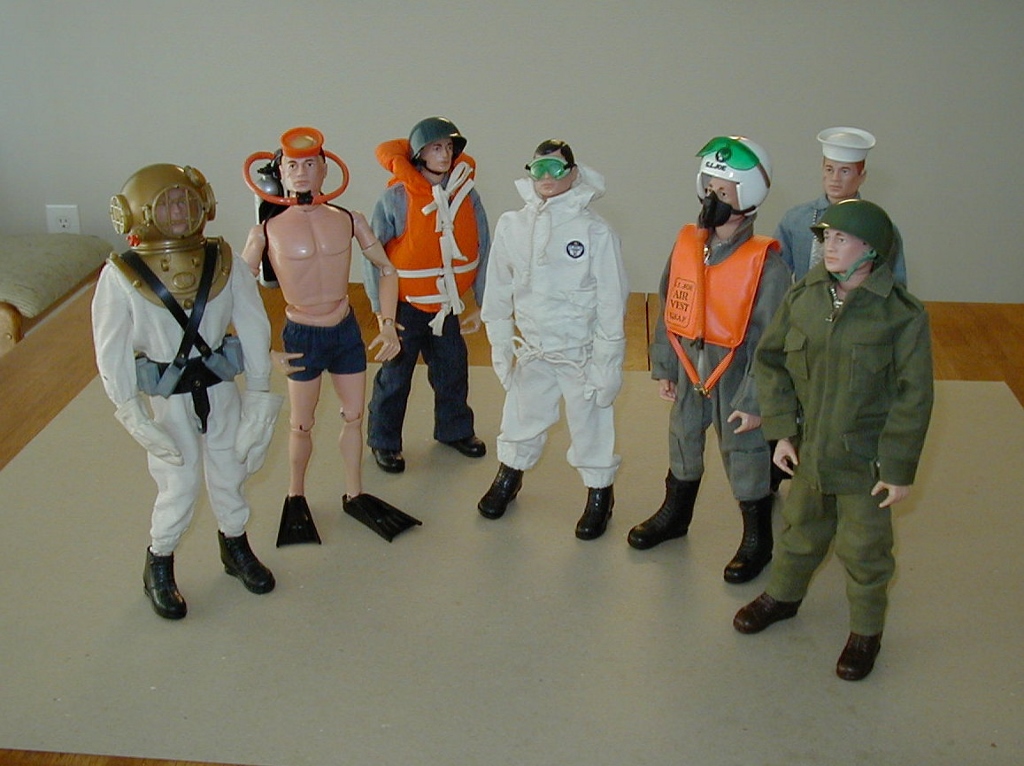
The third frame in the cartoon reveals a couple more of the GI Joe uniforms that Andy and George have in their collection. The picture below shows a close-up of that frame, along with another photo of the uniforms shown in the ad dressed on actual GI Joes.
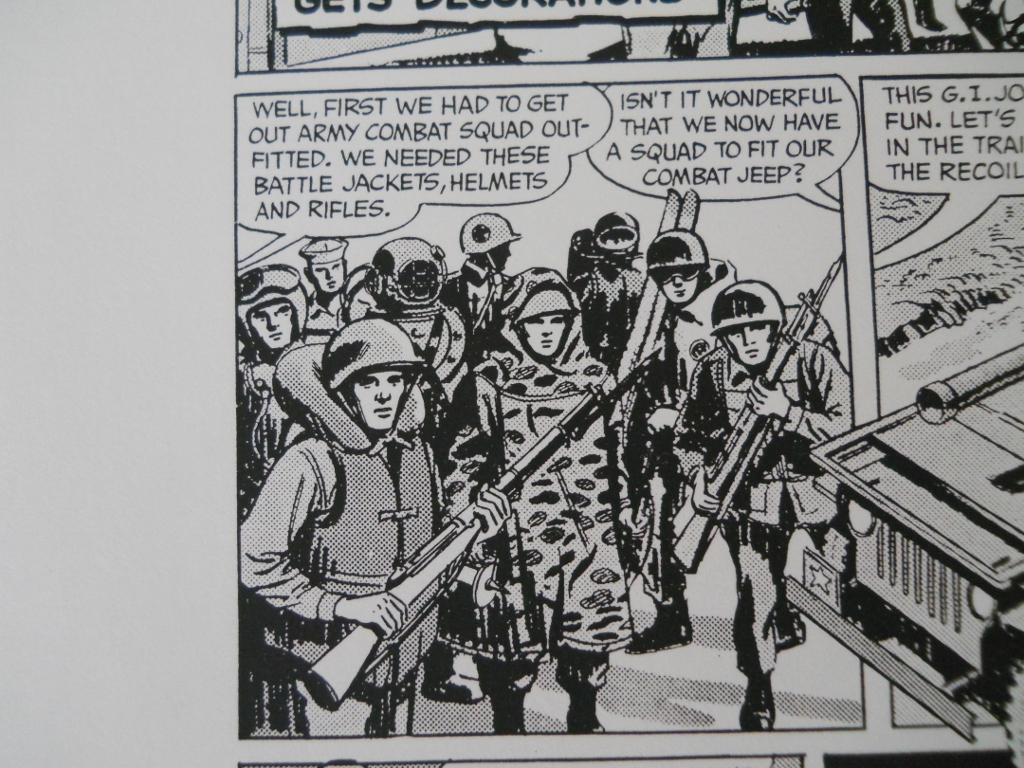

The sixth frame of the cartoon features the four "dress uniforms" that Andy and George are missing from their collection. The photos below show a close-up of this frame with the four dressed figures displayed directly beneath it.
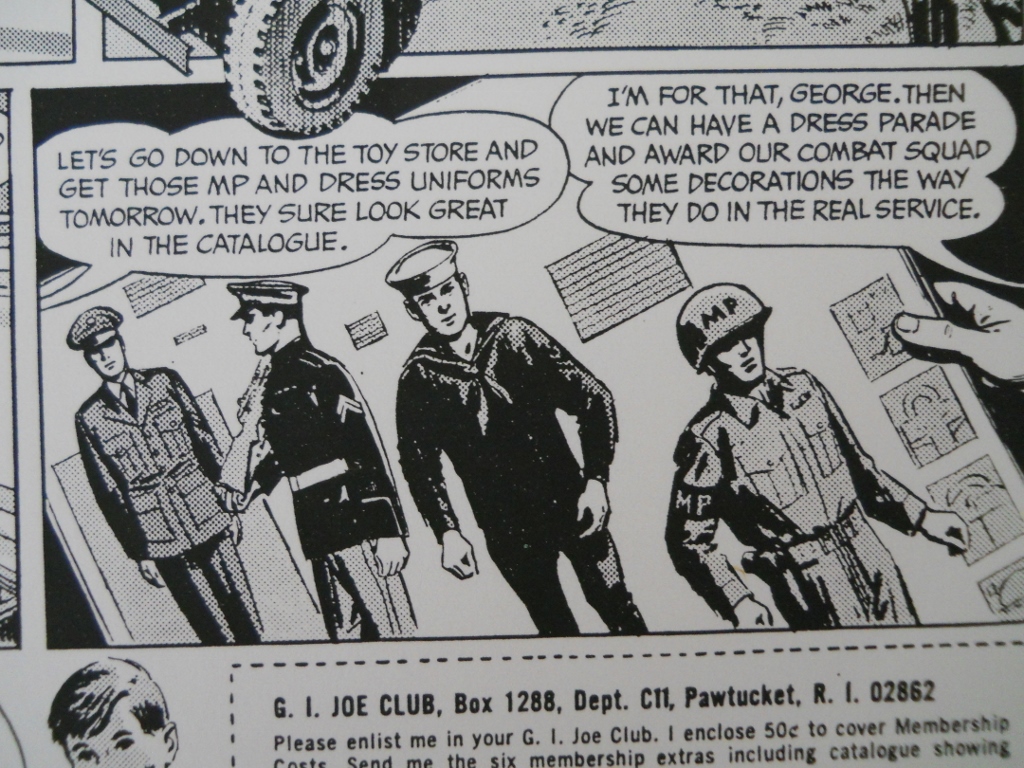
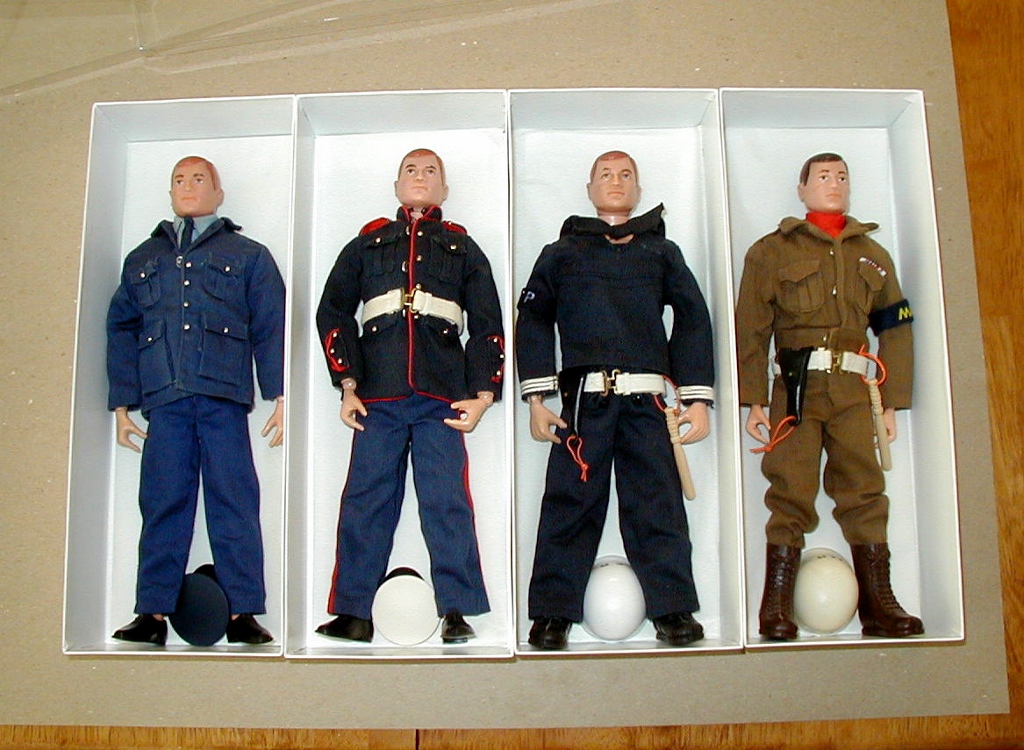
And, finally, the balloon caption at the bottom of the ad reiterates that there are "fifteen" different uniforms available for the GI Joe Soldier, Sailor, Pilot and Marine. The close-up photo below illustrates this.

So, the question that now remains is: "What are the fifteen different uniforms that Andy and George are referring to?"
From the ad's text and pictures, we know that Andy and George were missing the four dress uniforms, namely: the Dress Pilot, the Dress Marine, the Army M.P., and the Navy Shore Patrol. Deducting these four uniforms from the total of fifteen, we are left with eleven GI Joe uniforms to identify.
Andy and George state that they already have "nine" of the GI Joe uniforms. One of these nine is a sailor dressed in his "basics" uniform consisting of dungaree pants, cotton chambray shirt and white gob hat.
The other eight uniforms shown are: 1.) Combat Soldier in his combat field jacket, 2.) Navy Attack Sailor in his orange life jacket and blue attack helmet, 3.) Air Force Scramble Pilot, 4.) Navy Scuba Diver, 5.) Army Alpine Snow Troops, 6.) Deep Sea Diver, 7.) Communications Marine in his camouflage poncho, 8.) Marine Medic in medic helmet and arm bands.
So, after deducting the nine Andy & George outfits, we are still left with two unidentified GI Joe uniforms. One of these missing uniforms is likely the Communications Soldier in his olive-drab poncho. But, what was the final uniform?
Because this Andy & George ad appeared prior to the release of the Landing Signal Officer (Navy), the Crash Crew Firefighter (Air Force), the Green Beret (Army), and the Marine Minesweeper (Marines) sets, none of those uniforms could be part of the fifteen uniforms that Andy and George are talking about.
But thanks to the Vintage3Djoes.com website, and their decision to post all of the original Dietz GI Joe commercials (go to: http://www.vintage3djoes.com/commercial-viewing.html), this GI Joe mystery has now been solved.
The TV commercial Andy & George are referring to (Dietz commercial #620) states that there are "OVER fifteen different uniforms," NOT exactly 15 different uniforms, as stated in the DC comic book ad.
The commercial names 16 different uniform possibilities, and suggests even more.
Thus, Andy & George do not really have 9 out of 15 GI Joe uniforms; just 9 out of OVER 15 uniforms. If we consider the orange and gray flight suits as two different uniforms; add the olive-drab Army Poncho (the TV commercial only shows the Marine Poncho); add an Army Medic (as shown in the commercial) in addition to the Marine Medic; and factor in the four "basics" uniforms, there were more than 20 possible different uniform configurations.
Check out this cool vintage 1960's TV commercial by clicking on the above web link.
3.) 1967 Pan-American Games (Winnipeg) "Pepsi-Cola Premium" Sports Figures
In 1967, Winnipeg, Manitoba, Canada played host to the Pan-American Games and athletes from all parts of the Western Hemisphere were invited to compete for their countries in Olympic-style competition. In honour of these Games, Pepsi-Cola of Canada offered, for a limited time, a series of ten different gold-colored plastic sports figures as a premium when purchasing certain Pepsi products.

The above photo displays the ten different figures in this series. They are (from top left to bottom right): a discus thrower, a boxer, a swimmer, a sharpshooter, a runner, a javelin thrower, a soccer player, a weightlifter, a diver (or a gymnast, take your pick) and a fencer. The figures were approximately 60mm in height.
Figures were individually attached to Pepsi bottles (one figure per bottle) and, if all ten figures were collected, one could send away for a special "green and gold" plastic wall plaque, with ledges that each figure sat upon while on display.
The underside of each figure was simply marked "Tome, Pepsi-Cola" which translates to "Drink Pepsi-Cola" in Spanish. The photo below illustrates this.
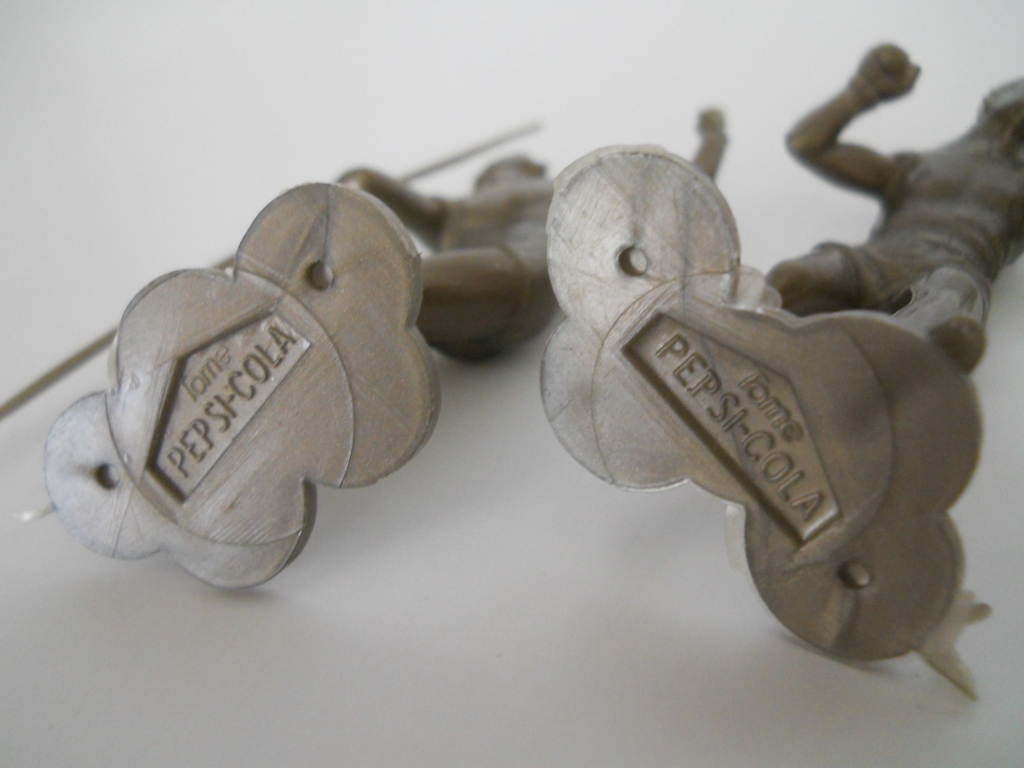
We have seen other identical vintage plastic sports figures to these, molded in different colors (usually in gray), and given this, we are uncertain as to whether or not these 1967 figures were the first to be produced. Be that as it may, we are confident that only the ones molded in this quasi-gold color, with the above printing under their base, are authentic "Pepsi-Cola" premium Pan-Am Games figures.
4.) (TEMPORARILY UNDER CONSTRUCTION)
This section is currently being revised.
New text and pictures to soon follow.
5.) Canadian Cereal Toy Premiums
For 1960's youngsters (especially boys), roaming up and down a supermarket cereal aisle was the next best thing to being in a toy store. Cereal manufacturers were constantly trying to attract the attention of children by offering a wide range of free toy premiums inside their products, thus putting pressure on parents to purchase them.
Inside local Safeway, Solo, Dominion, IGA and Loblaw's stores, Canadian consumers had direct access to the full range of Kellogg's, Post, Quaker, Nabisco, General Mills and other breakfast cereal product brands.
i.) Kellogg's Big Game Hunter's Wild Animals
One of the more memorable cereal premium offerings, found in boxes of Kellogg's Corn Flakes, was the "Big Game Hunter's Wild Animals" series. The photo below shows my collection of these Lido-brand plastic animal figures in a wide range of colors. We have been told that the figures that could be found inside Canadian Kellogg's cereal boxes only came in four colors; either brown, tan, cream or soft green. The other various colors shown below were likely made by Lido (the manufacturer) for sale in retail stores, but the other colors were not originally found in Kellogg's boxes in the 1960's.

But trying to collect a complete set in any one matching color can be quite the challenge.
The photo below shows the back of a Canadian (bilingual) Kellogg's Corn Flakes cereal box. There were 10 different figures that could be collected. The photo beneath it shows all ten different figures.


The 10 different animals in this series, as listed on the back of cereal boxes, were: 1.) bear, 2.) gorilla, 3.) bison (buffalo), 4.) camel, 5.) moose, 6.) elephant, 7.) lion, 8.) rhinoceros, 9.) giraffe, 10.) hippopotamus.
ii.) Kellogg's "Marx" Robin Hood Cereal Premium Figures
In Canadian Kellogg's cereal boxes during the 1960s, some of the plastic toy premium figures given away were made from "Marx Toys" molds. Shown below are a number of vintage "Robin Hood" cereal premium figures. In the next photo beneath it, we have contrasted these Canadian figures against a batch of "Made in U.S.A." Marx Robin Hood figures that came from an original 1950's/60's Marx Playset. Notice the difference in the color of the original "blue-green" U.S. figures versus the Canadian ones. Also, note that none of the Canadian cereal premiums came in a "tan" color, all of the Canadian cereal figures were green.
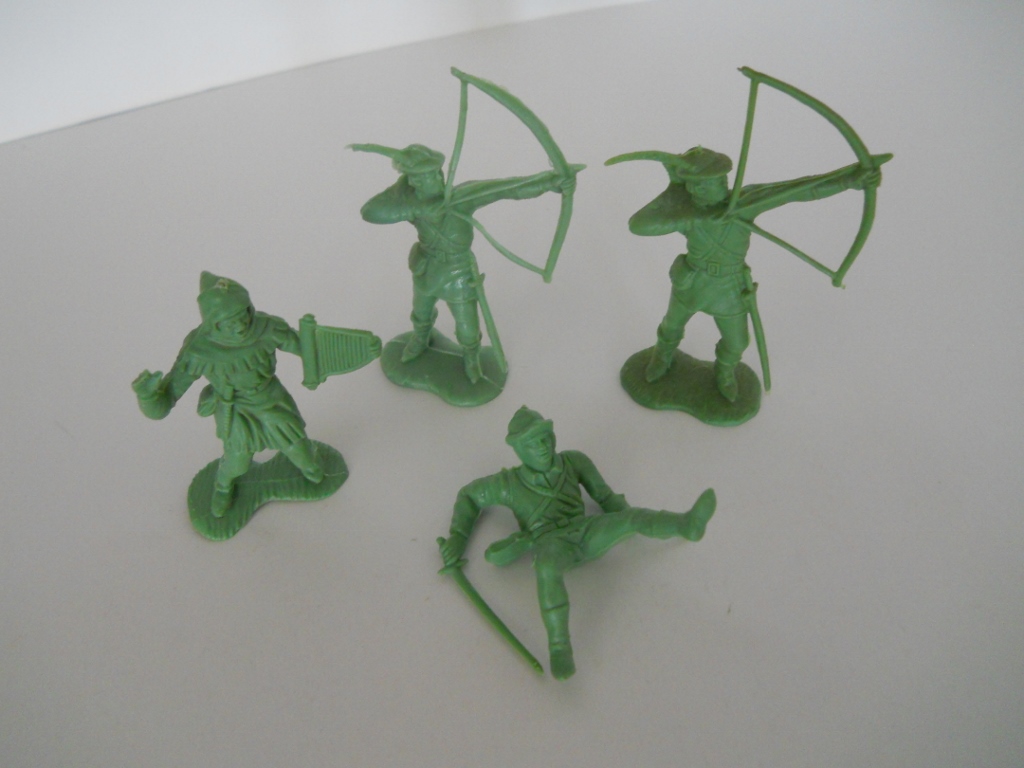

iii.) "Marx" Eskimo Cereal Premium Figures
Shortly following the release of the "Marx" Robin Hood figures in Canadian cereal boxes, a series of "Marx" Eskimo figures was also offered. The photo below shows a small sampling of these Eskimo cereal premiums. Like the Robin Hood figures, there was a color variation between the Canadian figures and the original Marx playset figures. U.S. made figures are of a much lighter blue tone than the Canadian premium figures, which are brighter blue.

iv.) "Ajax" Dinosaur Cereal Premiums
In the 1960's, dinosaurs were of just as much interest to kids as they are today. A series of dinosaurs based on the "Ajax" toy company molds were given away in Canadian cereal boxes and the photo below illustrates the eight different versions then available. These cereal premium figures came in four assorted colors (dark chocolate brown, gray, dark green and tan) as displayed in the photo below (however, the Triceratops figure shown in bright blue is a much more recent recast and is not an original figure). When I was young, I had the Tyrannosaurus Rex (in gray), the Brontosaurus (in brown), and several of the Pterodactyls in both gray and brown.

v.) Kellogg's "Lido" Hockey Players
These plastic hockey players were manufactured from "Lido" toy molds and distributed as premiums in the late 1950's and early 1960's in Canadian cereal boxes. These cereal figures came in three basic colors: a dark cherry red, very dark blue and bright white. (N.B. These figures were also manufactured for other forms of distribution as well and the tip-off that they may not be 1960's Canadian cereal premium figures is if the blue and red colors are lighter in tone, and when compared to the Canadian cereal premium figures, are slightly smaller in scale.)
The first photo below shows a few of the original "dark blue" and "cherry red" premium figures and the second photo shows a grouping of the "bright white" cereal premiums.
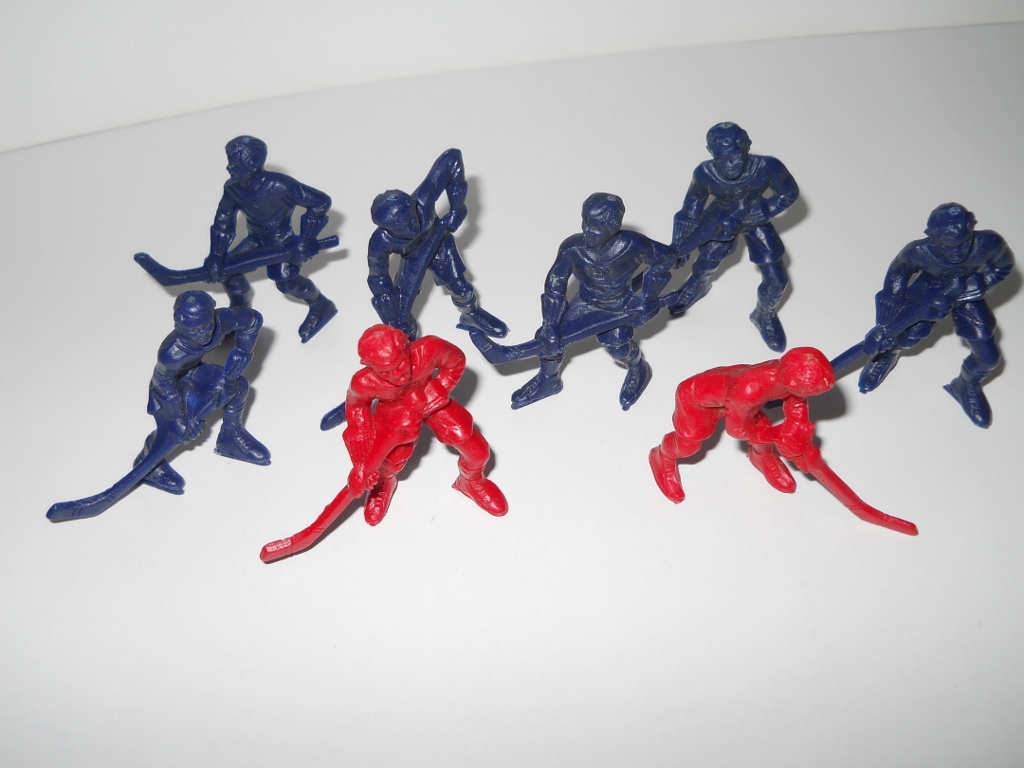

vi.) Kellogg's "Lido" Baseball Player Cereal Premium Figures
During the early 1960's, Canadian Kellogg's Frosted Flakes cereal boxes contained a series of "baseball player" plastic toy premiums. They were made from "Lido" baseball player molds and, in terms of size, quality and design, they were very similar. The ones that I recall having were all molded in "gray" plastic, but they may have been available in tan color, too; of that, I'm uncertain. (Note: The light gray pitcher in the back row is not a "Lido" figure, but a "Marx" sports character and the bright blue figure is a much later recast and not a cereal premium figure.)
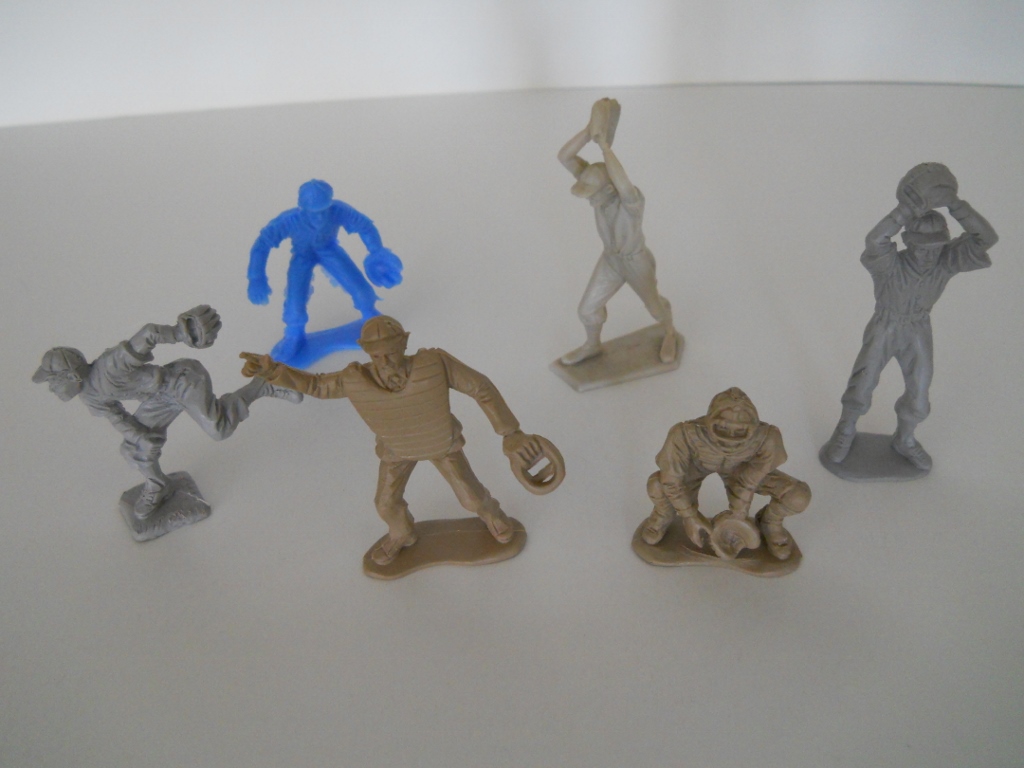
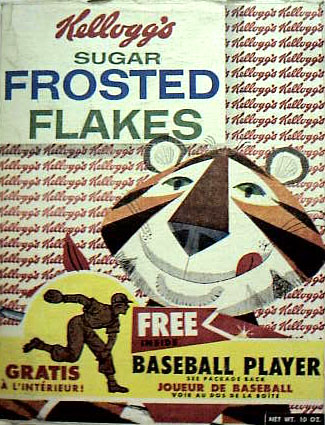
vii.) Walt Disney "Spoon Sitters" and "Jungle Book" Cereal Premiums
Shown below is a set of four brightly-colored "Disney" cereal premium figures. These characters could either be used as "spoon sitters" (they had a groove located underneath each figure for a spoon's handle to slide through) or as "cereal bowl sitters" (hanging on to the edge of the bowl with their two curved hands) or as "pencil toppers." The four Disney characters in the first series were: Pluto, Mickey Mouse, Donald Duck and Goofy.
Following this, a second series of four additional figures, based on the Disney "Pinocchio" animated movie, were released in cereal boxes. Shown in the back row (l to r) are: Geppetto, Pinocchio and Jiminy Cricket (Figaro, the cat, is missing from the photo).
Later still, yet another series of "spoon sitter" figures was released, based on the Disney "Winnie-the-Pooh" movie. Those figures were also distributed as premiums inside of Canadian cereal boxes.

With the popularity of these "spoon sitters" as cereal premiums, McDonald's Restaurants also issued their own series of similar-scale "spoon sitters" as fast food premiums, based on Ronald McDonald and the other McDonald's characters.
A different design of "bowl sitters" was manufactured following the release of the 1967 Disney "Jungle Book" movie. These premiums were similar in nature to the figures found in the then popular "Barrel of Monkeys" game, as they possessed curved appendages with which to link onto objects, or to one another. Shown below are the six figures in this series: Baloo, the Bear; Buzzie, the Vulture; Kaa, the Snake; Bagheera, the Panther; King Louie, the Orangutan; and Mowgli, a young boy.

viii.) Kellogg's "Soldiers of the Ages" Cereal Premium Figures
Shown below are nine Kellogg's "Soldiers of the Ages" figures in 7 different poses. These premium figures were molded in either "gold" or "silver" plastic. The photo depicts (back row to front): 1 Swiss Crossbowman, 2 Foreign Legionnaires, 1 U.S. 7th Cavalryman, 1 Zulu Warrior, 1 Mexican Warrior, 1 Spanish Conquistador and 2 Vikings.

Note: Pictured on the far left in the photo is a white "Nabisco" Davy Crockett figure which I purchased in the U.S. and was never offered as a premium inside a Canadian cereal box (to the best of my knowledge.)
ix.) Kellogg's "Lido" Cowboys and Indians
Yet another series of plastic cereal premium figures that was available on both sides of the border was the colorful Kellogg's "Cowboys and Indians" toy line. The photo below depicts seven of these figures in five different poses. The back cover of a vintage cereal box is shown next to them.


x.) Kellogg's "Rice Krispies" Farmyard Animals
During the 1960s, Kellogg's "Rice Krispies" cereal boxes contained one of eight different plastic farmyard animals. The photo below displays these animals in assorted colors. Also shown below is the back of a Rice Krispies box illustrating them.
They farmyard animals were: 1.) a chicken, 2.) a duck, 3.) a baby pig, 4.) an adult pig, 5.) a rooster, 6.) a calf, 7.) a sheep, 8.) a horse.


The plastic farm animals pictured above were identical to "Reliable Toys" brand farm animals that were sold at the time in retail stores. They were molded after the "Auburn Toys" farm animals of the same design, but both the cereal premium animals and the Reliable animals were made from poly-plastic while the earlier Auburn animals were made from a soft and bendable vinyl plastic.
xi,) Other Canadian Cereal Premiums
We are unsure as to whether or not the yellow "Lido Indian" in the photo below was ever a cereal premium; we are only certain that this figure was available in Canada in the 1960's and that it is slightly larger in scale than the Kellogg's Lido "Cowboy and Indian" cereal premium figures shown above.
We are certain, however, that the metallic blue "Marx" British Queen's Life Guardsman, as shown below, was a Canadian cereal premium item in the 1960s. These Marx cereal premium figures came in three different colors: metallic blue (as shown), white and red.

6.) Vintage 1970's Archie Comics Digests
Publication of the Archie Comics Digest Series commenced with the appearance of the August 1973 issue of ARCHIE COMICS DIGEST, NO. 1 in June of 1973.
Baaed on the sales success of Archie Digest #'s 1-4, a second bi-monthly digest series soon followed with the March 1974 edition of JUGHEAD WITH ARCHIE DIGEST, NO. 1. (The actual name of the first two editions of the digest was "Jughead With Archie Plus Betty and Veronica and Reggie, too" Digest; the name was then shortened to just "Jughead With Archie" digest commencing with issue number three.)
The third title in the series was originally intended to be an annual. LAUGH DIGEST, NO. 1 was released with an issue date of August, 1974. The second issue of this digest was released with an issue date of September, 1975; but, with the success of the other Archie Series digest titles, the third edition was released with an issue date of March, 1976 and the digest's frequency was changed to bi-monthly.
Shown below, in chronological order of their issue dates, are the first 30 digests in the ARCHIE COMICS DIGEST SERIES, commencing with ARCHIE COMICS DIGEST, NO. 1 (August, 1973) and ending with ARCHIE COMICS DIGEST, NO. 15 (December, 1975).

A small handful of Archie Series Digests were released as either "annual" or "semi-annual" editions and, as such, do not display precise "issue dates" inside of them. A few of the early titles that were printed with no issue dates include: Mad House Comics Digest, Archie Annual Digest, Joke Book Digest, Little Archie Digest and Archie's Super-Hero Digest. Instead of a precise issue date, they would only contain reference to the "year" of release. In some instances, when two issues were released within the same calendar year, the first issue of the year would show only the calendar year, such as "1976 Edition," and the second issue would have a hyphenated date that spanned the following year, such as "1976/77 Edition." Subsequently, the practice of using a hyphenated two-year date was dropped and both issues released in the same year would bear the exact same date indicator (e. g. "1977 Edition").
With respect to Archie Annual Digest, it is important to note that issues #1 to #26 of Archie Annual were printed in "regular comic book form" and that this publication only transitioned over to a digest commencing with issue #27. Thus, issue #27 of Archie Annual Digest is, for all intents and purposes, actually issue No. 1 of this particular comics digest.
Listed below, we have displayed the "annualized" issue dates that appear inside each of these "annual" or "semi-annual" digests (up until the end of 1979), with the "equivalent" issue date for each edition, had they been printed with a regular "month and year" date instead at the time (similar to the other Archie Digest series digests issued concurrent with their release).
Archie Annual Digest (Semi-Annual): Issue #27 - 1975/76 Edition - August, 1975; Issue #28 - 1976 Edition - March, 1976; Issue #29 - 1976/77 Edition - August, 1976; Issue #30 - 1977 Edition - March, 1977; Issue #31 - 1977 Edition - August, 1977; Issue #32 - 1978 Edition - March, 1978; Issue #33 - 1978 Edition - August, 1978; Issue #34 - 1979 Edition - March, 1979; Issue #35 - 1979 Edition - August, 1979.
Mad House Comics Digest (Annual): Issue #1 - 1975/76 Edition - September, 1975; Issue #2 - 1976/77 Edition - September, 1976; Issue #3 - 1977/78 Edition - September, 1977; Issue #4 - 1978/79 Edition - September, 1978; Issue #5 - 1979/80 Edition - September, 1979.
Joke Book Comics Digest Annual (Semi-Annual): - Issue #1 - 1977 Edition - October, 1977; Issue #2 - 1978 Edition - April, 1978; Issue #3 - 1978 Edition - October, 1978; Issue #4 - 1979 Edition - April, 1979; Issue #5 - 1979 Edition - October, 1979.
Little Archie Comics Digest Annual (Semi-Annual): - Issue #1 - 1977 Edition - October, 1977; Issue #2 - 1978 Edition - April, 1978; Issue #3 - 1978 Edition - October, 1978; Issue #4 - 1979 Edition - April, 1979; Issue #5 - 1979 Edition - October, 1979.
Archie's Super-Hero Comics Digest (Semi-Annual): Issue #1 - 1978 Edition - January, 1979; Issue #2 - 1979 Edition - July, 1979. (Issue #1 was titled "Archie's Super-Hero Special;" this Archie Series digest only ran for the above two issues).
ARCHIE DIGEST SERIES ISSUE DATES (By Year)
1973 (3 digests released)
Archie Comics Digest - #1 August, #2 October, #3 December
1974 (12 digests released)
Archie Comics Digest - #4 February, #5 April, #6 June, #7 August, #8 October, #9 December
Jughead With Archie Digest - #1 March, #2 May, #3 July, #4 September, #5 November
Laugh Comics Digest - #1 August
1975 (15 digests released)
Archie Comics Digest - #10 February, #11 April, #12 June, #13 August, #14 October, #15 December
Jughead With Archie Digest - #6 January, #7 March, #8 May, #9 July, #10 September, #11 November
Laugh Comics Digest - #2 September
Archie Annual Digest - #27 August
Mad House Digest - #1 September
1976 (20 digests released)
Archie Comics Digest - #16 February, #17 April, #18 June, #19 August, #20 October, #21 December
Jughead With Archie Digest - #12 January, #13 March, #14 May, #15 July, #16 September, #17 November
Laugh Comics Digest - #3 March, #4 May, #5 July, #6 September, #7 November
Archie Annual Digest - #28 March, #29 August
Mad House Digest - #2 September
1977 (30 digests released)
Archie Comics Digest - #22 February, #23 April, #24 June, #25 August, #26 October, #27 December
Jughead With Archie Digest - #18 January, #19 March, #20 May, #21 July, #22 September, #23 November
Laugh Comics Digest - #8 January, #9 March, #10 May, #11 July, #12 September, #13 November
Archie Annual Digest - #30 March, #31 August
Mad House Digest - #3 September
Archie, Archie Andrews Where Are You? Digest - #1 February, #2 May, #3 August, #4 November
Jughead Jones Digest - #1 June, #2 September, #3 December
Joke Book Digest - #1 October
Little Archie Digest - #1 October
1978 (31 digests released)
Archie Comics Digest - #28 February, #29 April, #30 June, #31 August, #32 October, #33 December
Jughead With Archie Digest - #24 January, #25 March, #26 May, #27 July, #28 September, #29 November
Laugh Comics Digest - #14 January, #15 March, #16 May, #17 July, #18 September, #19 November
Archie Annual Digest - #32 March, #33 August
Mad House Digest - #4 September
Archie, Archie Andrews Where Are You? Digest - #5 March, #6 May, #7 August, #8 November
Jughead Jones Digest - #4 March, #5 June, #6 September, #7 December
Joke Book Digest - #2 - April, #3 October
Little Archie Digest - #2 April, #3 October
1979 (33 digests released)
Archie Comics Digest - #34 February, #35 April, #36 June, #37 August, #38 October, #39 December
Jughead With Archie Digest - #30 January, #31 March, #32 May, #33 July, #34 September, #35 November (N.B. November 1979 editions are misprinted as "November 1980."
Laugh Comics Digest - #20 January, #21 March, #22 May, #23 July, #24 September, #25 November
Archie Annual Digest - #34 March, #35 August
Mad House Digest - #5 September
Archie, Archie Andrews Where Are You? Digest - #9 February, #10 May, #11 August, #12 November
Jughead Jones Digest - #8 March, #9 July, #10 September, #11 December
Joke Book Digest - #4 April, #5 October
Little Archie Digest - #4 April, #5 October
Archie's Super-Hero Comics Digest - #1 January, #2 July (final issue)
1980 (first two months) - (4 issues) (technically "1979" issues as they were released to retailers in calendar year 1979)
Archie Comics Digest - #40 February
Jughead With Archie Digest - #36 January
Laugh Digest - #26 January
Archie, Archie Andrews Where Are You? Digest - #13 February
------------------------
Of the ten different Archie Series Digests printed during the 1970's, the following list provides the correct chronological order of their first appearances.
1.) Archie Comics Digest - August, 1973; 2.) Jughead With Archie Digest - March, 1974; 3.) Laugh Comics Digest - August, 1974; 4.) Archie Annual Digest - August, 1975; 5.) Mad House Comics Digest - September, 1975; 6.) Archie, Archie Andrews, Where Are You? Digest - February, 1977; 7.) The Jughead Jones Comics Digest - June, 1977; 8.) Joke Book Comics Digest Annual - October, 1977; 9.) Little Archie Comics Digest Annual - October, 1977; 10.) Archie's Super-Hero Comics Digest - January, 1979.
7.) Vintage 1960's Series Books
We have already extensively outlined the 1960's success of publisher, Grosset & Dunlap, in the field of children's books with our "How & Why Wonder Book" sections, but there were other players with a vested interest in the children's marketplace, too. One of Grosset & Dunlap's main competitors when it came to beautifully designed and crafted hardcover books was Random House. (Ironically enough, thanks to the preponderance of book company mergers over more recent decades, the Grosset & Dunlap imprint is now wholly owned by Penguin Random House.)

Book #4 - BARBIE AND KEN by Cynthia Lawrence and Better Lou Maybee, Illustrated by Clyde Smith, 1963, Random House, Inc.
Book #5 - BARBIE SOLVES A MYSTERY by Cynthia Lawrence, Illustrated by Clyde Smith, 1963, Random House, Inc.
Book #6 - BARBIE'S HAWAIIAN HOLIDAY by Bette Lou Maybee, Illustrated by Clyde Smith, 1963, Random House, Inc.
Book #8 - BARBIE IN TELEVISION by Marianne Duest, Illustrated by Robert Patterson, 1964, Random House, Inc.
Book #9 - BARBIE, MIDGE AND KEN by Cynthia Lawrence and Bette Lou Maybee, Illustrated by Robert Patterson, 1964, Random House, Inc.
Another competitor of both Random House and Grosset & Dunlap in the 1960's book market was Whitman. Shown below are some of the Tarzan titles that were published under the Whitman logo.
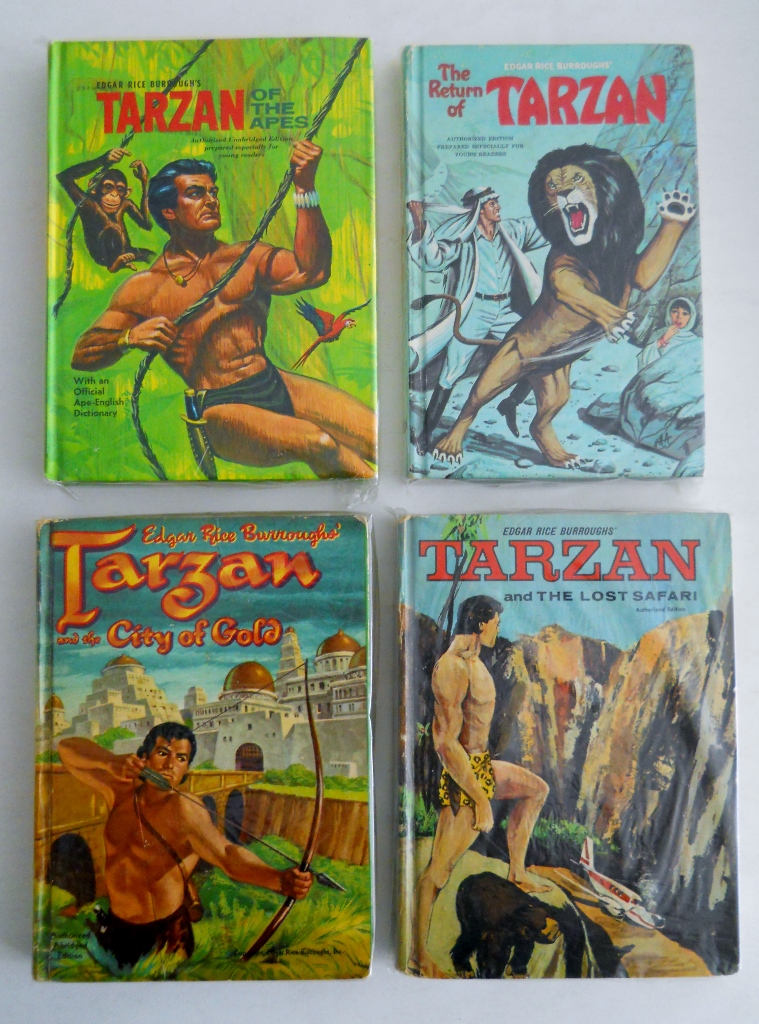
TARZAN OF THE APES by Edgar Rice Burroughs, Whitman Book #1507
THE RETURN OF TARZAN by Edgar Rice Burroughs, Whitman Book #1506
TARZAN AND THE CITY OF GOLD by Edgar Rice Burroughs, Whitman Book #1533
TARZAN AND THE LOST SAFARI by Frank Castle, Whitman Book #1534
Tempo Paperback BooksDuring the 1960s, yet more popular children's series were published by Grosset and Dunlap in paperback format under their "Tempo" logo imprint.
Initially, books printed under the Tempo imprint had two sets of identification numbers on them. The first was a series of "T-numbers," which appeared on the face of front covers. Tempo paperbacks also displayed a standard four-digit G&D book number at the base of each spine, underneath the classic "five-diamond" Tempo symbol. (For example, book #T-1, Francie, was also G&D book #4701.)
The Tempo "T-Series" ran from book #T-1 to book #T-199 (G&D books #4701 to #4899).
A few of our favourite Tempo "series" titles are as shown below.

Shown above are: Get Smart Series: T-103 (#4803) Get Smart, T-119 (#4819) Sorry, Chief, T-121 (#4821) Get Smart Once Again, T-140 (#4840) Max Smart and the Perilous Pellets, T-154 (#4854) Missed It By That Much, T-159 (#4859) And Loving It, T-174 (#4874) Max Smart, The Spy Who Went Out to the Cold; Win Hadley Sports Series: T-8 (#4708) Winning Pitcher, T-113 (#4813) Set Point, T-145 (#4845) Duel on the Cinders; Sandy Steele Adventure Series: T-22 (#4722) Black Treasure, T-36 (#4736) Danger at Mormon Crossing, T-57 (#4757) Stormy Voyage, T-125 (#4825) Troubled Waters; Rod Serling's Twilight Zone Series: T-89 (#4789) Rod Serling's The Twilight Zone, T-171 (#4871) Rod Serling's Twilight Zone Revisited; Connie Blair Mystery Series: T-99 (#4799) The Clue in Blue, T-100 (#4800) The Riddle in Red, T-101 (#4801) Puzzle in Purple, T-116 (#4816) The Yellow Warning.
For a much more comprehensive view of the covers of most of the Tempo "T-number" books, we suggest that you to go to Bookscans.com (www.bookscans.com/Publishers/tempo/tempo1.htm) in order to view them.
"THANKS FOR DROPPING BY AND, PLEASE, COME BACK AGAIN SOON!"
